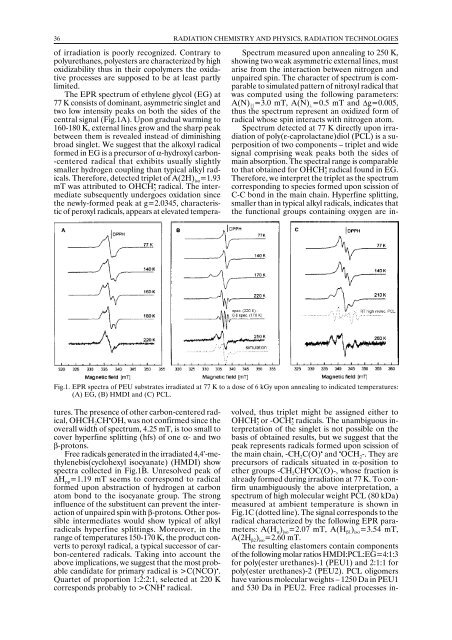annual report annual report annual report annual report 2005
annual report annual report annual report annual report 2005
annual report annual report annual report annual report 2005
You also want an ePaper? Increase the reach of your titles
YUMPU automatically turns print PDFs into web optimized ePapers that Google loves.
36<br />
RADIATION CHEMISTRY AND PHYSICS, RADIATION TECHNOLOGIES<br />
Fig.1. EPR spectra of PEU substrates irradiated at 77 K to a dose of 6 kGy upon annealing to indicated temperatures:<br />
(A) EG, (B) HMDI and (C) PCL.<br />
volved, thus triplet might be assigned either to<br />
OHCH 2<br />
•<br />
or -OCH 2<br />
•<br />
radicals. The unambiguous interpretation<br />
of the singlet is not possible on the<br />
basis of obtained results, but we suggest that the<br />
peak represents radicals formed upon scission of<br />
the main chain, -CH 2 C(O) • and • OCH 2 -. They are<br />
precursors of radicals situated in α-position to<br />
ether groups -CH 2 CH • OC(O)-, whose fraction is<br />
already formed during irradiation at 77 K. To confirm<br />
unambiguously the above interpretation, a<br />
spectrum of high molecular weight PCL (80 kDa)<br />
measured at ambient temperature is shown in<br />
Fig.1C (dotted line). The signal corresponds to the<br />
radical characterized by the following EPR parameters:<br />
A(H α ) iso =2.07 mT, A(H β1 ) iso =3.54 mT,<br />
A(2H β2 ) iso =2.60 mT.<br />
The resulting elastomers contain components<br />
of the following molar ratios HMDI:PCL:EG=4:1:3<br />
for poly(ester urethanes)-1 (PEU1) and 2:1:1 for<br />
poly(ester urethanes)-2 (PEU2). PCL oligomers<br />
have various molecular weights – 1250 Da in PEU1<br />
and 530 Da in PEU2. Free radical processes inof<br />
irradiation is poorly recognized. Contrary to<br />
polyurethanes, polyesters are characterized by high<br />
oxidizability thus in their copolymers the oxidative<br />
processes are supposed to be at least partly<br />
limited.<br />
The EPR spectrum of ethylene glycol (EG) at<br />
77 K consists of dominant, asymmetric singlet and<br />
two low intensity peaks on both the sides of the<br />
central signal (Fig.1A). Upon gradual warming to<br />
160-180 K, external lines grow and the sharp peak<br />
between them is revealed instead of diminishing<br />
broad singlet. We suggest that the alkoxyl radical<br />
formed in EG is a precursor of α-hydroxyl carbon-<br />
-centered radical that exhibits usually slightly<br />
smaller hydrogen coupling than typical alkyl radicals.<br />
Therefore, detected triplet of A(2H) iso =1.93<br />
mT was attributed to OHCH 2<br />
•<br />
radical. The intermediate<br />
subsequently undergoes oxidation since<br />
the newly-formed peak at g=2.0345, characteristic<br />
of peroxyl radicals, appears at elevated temperatures.<br />
The presence of other carbon-centered radical,<br />
OHCH 2 CH • OH, was not confirmed since the<br />
overall width of spectrum, 4.25 mT, is too small to<br />
cover hyperfine splitting (hfs) of one α- and two<br />
β-protons.<br />
Free radicals generated in the irradiated 4,4’-methylenebis(cyclohexyl<br />
isocyanate) (HMDI) show<br />
spectra collected in Fig.1B. Unresolved peak of<br />
∆H pp =1.19 mT seems to correspond to radical<br />
formed upon abstraction of hydrogen at carbon<br />
atom bond to the isocyanate group. The strong<br />
influence of the substituent can prevent the interaction<br />
of unpaired spin with β-protons. Other possible<br />
intermediates would show typical of alkyl<br />
radicals hyperfine splittings. Moreover, in the<br />
range of temperatures 150-170 K, the product converts<br />
to peroxyl radical, a typical successor of carbon-centered<br />
radicals. Taking into account the<br />
above implications, we suggest that the most probable<br />
candidate for primary radical is >C(NCO) • .<br />
Quartet of proportion 1:2:2:1, selected at 220 K<br />
corresponds probably to >CNH • radical.<br />
Spectrum measured upon annealing to 250 K,<br />
showing two weak asymmetric external lines, must<br />
arise from the interaction between nitrogen and<br />
unpaired spin. The character of spectrum is comparable<br />
to simulated pattern of nitroxyl radical that<br />
was computed using the following parameters:<br />
A(N) || =3.0 mT, A(N) ⊥ =0.5 mT and ∆g=0.005,<br />
thus the spectrum represent an oxidized form of<br />
radical whose spin interacts with nitrogen atom.<br />
Spectrum detected at 77 K directly upon irradiation<br />
of poly(ε-caprolactane)diol (PCL) is a superposition<br />
of two components – triplet and wide<br />
signal comprising weak peaks both the sides of<br />
main absorption. The spectral range is comparable<br />
to that obtained for OHCH 2<br />
•<br />
radical found in EG.<br />
Therefore, we interpret the triplet as the spectrum<br />
corresponding to species formed upon scission of<br />
C-C bond in the main chain. Hyperfine splitting,<br />
smaller than in typical alkyl radicals, indicates that<br />
the functional groups containing oxygen are in-
















